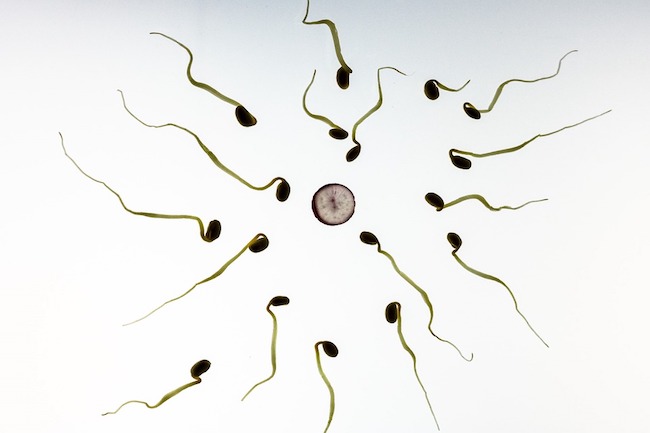Sperm Counts Are Declining at Accelerating Rates Worldwide by Dr. Joseph Mercola
GNN Note – This ties in perfectly with our ongoing series – Essence Of Collapse. Read all installments by clicking here >>>
STORY AT-A-GLANCE
- Men experienced a 50% to 60% decline in sperm counts from 1973 to 2011, according to a 2017 study published in Human Reproduction Update
- A 2022 update to the study includes data from 53 countries and an additional seven years — 2011 to 2018 — and the results are alarmingly similar
- Sperm concentration declined “appreciably” by 51.6% from 1973 to 2018
- The percent decline per year doubled, increasing from 1.16% after 1972 to 2.64% after 2000
- Total sperm count also declined at an alarming level — 62.3% from 1973 to 2018
- The study authors believe lifestyle choices and endocrine-disrupting chemicals in the environment are key culprits in the declines
An impending fertility crisis is upon us. Men experienced a 50% to 60% decline in sperm counts from 1973 to 2011, according to a 2017 study published in Human Reproduction Update.1 That study included men from North America, Europe, Australia and New Zealand, but was criticized because it didn’t include global data.
“At that time, there were too few studies with data from South/Central America-Asia-Africa (SAA) to reliably estimate trends among men from these continents,” the research team explained in a 2022 update.2 The new study includes data from 53 countries and an additional seven years3 — 2011 to 2018 — but the results are alarmingly similar.
Sperm Counts Declined 62% Since 1973
The systematic review and meta-analysis includes data from 223 studies and 57,168 men.4 Sperm concentration declined “appreciably” by 51.6% from 1973 to 2018. The percent decline per year more than doubled, increasing from 1.16% after 1972 to 2.64% after 2000.5
Total sperm count also declined at an alarming level — 62.3% from 1973 to 2018. “This analysis is the first to report a decline in sperm count among unselected men from South/Central America-Asia-Africa, in contrast to our previous meta-analysis that was underpowered to examine those continents … data suggest that this worldwide decline is continuing in the 21st century at an accelerated pace,” the researchers noted.6
Lead study author Hagai Levine of Hebrew University of Jerusalem’s Hadassah Braun School of Public Health called the findings “a canary in a coal mine,” pointing out that sperm counts are not only an indicator of fertility but also men’s health overall. Low sperm count is associated with an increased risk of chronic disease, testicular cancer and decreased lifespan.7
“Overall, we’re seeing a significant worldwide decline in sperm counts of over 50% in the past 46 years, a decline that has accelerated in recent years,” Levine said. “… We have a serious problem on our hands that, if not mitigated, could threaten mankind’s survival. We urgently call for global action to promoted healthier environments for all species and reduce exposures and behaviors that threaten our reproductive health.”8
Could Sperm Counts Decline to Zero?
Shanna Swan at the Icahn School of Medicine, Mount Sinai, New York, who was also involved in the study, warned in 2021 that if the curve of declining sperm counts from the 2017 study continues, by 2045 the median sperm count will be zero. “It is speculative to extrapolate, but there is also no evidence that it is tapering off. This means that most couples may have to use assisted reproduction,” she said.9
Now, however, declining sperm counts have accelerated. Swan’s book, “Count Down,” goes into detail about how the modern world not only is threatening sperm counts but also altering reproductive development in males and females,10 and in so doing “imperiling the future of the human race.”11
An alarming synergy is occurring as well, which “Count Down” dubs “the 1% effect,” because sperm count, testosterone and fertility are dropping, and testicular cancer and miscarriage are rising, all at about 1% per year.12 Erectile dysfunction and the rate of gestational surrogacy are also increasing by about 1% a year, while the global total fertility rate dropped by close to 1% from 1960 to 2018.13
All of these concerning reproductive changes occurring in unison are not a coincidence, according to Swan. “They’re just too synchronous for that to be possible,” she wrote in Scientific American.14While there are likely a whole host of factors contributing to this reproductive calamity, Swan believes we can rule out genetics, because the decline in sperm count is simply too rapid.
While the featured study did not address potential causes of sperm count declines, Levine stated that disturbances to reproductive development during fetal life are involved and “lifestyle choices and chemicals in the environment are adversely affecting this fetal development.”15 Swan added in a news release:16
“The troubling declines in men’s sperm concentration and total sperm counts at over 1% each year as reported in our paper are consistent with adverse trends in other men’s health outcomes, such as testicular cancer, hormonal disruption, and genital birth defects, as well as declines in female reproductive health. This clearly cannot continue unchecked.”




